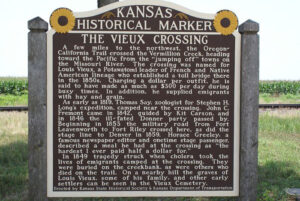Vieux Crossing, Kansas – On the Oregon Trail – Legends of America (original) (raw)

Red Vermillion Crossing on the Oregon Trail, by Frank Thompson.
Vieux Crossing, also called the Red Vermillion Crossing, was where the Oregon and California Trails crossed the Red Vermillion River or the Little Vermillion River about three miles east of Louisville, Kansas, in Pottawatomie County.

Vieux Crossing Historical Marker.
Travelers began using the crossing as early as 1819, when Thomas Say, a member of Stephen H. Long’s expedition, camped near it. By the 1840s, it was regularly used. Kit Carson and John C. Fremont crossed here in 1842 and the ill-fated Donner Party in 1846.
The west side of the river was the first significant campsite, about a day’s journey from St. Mary’s Mission. However, fording the river was difficult and risky. Wagons had to be lowered down the steep bank with ropes, floated across the river, and hauled up the other side. A large wagon train could take two days to cross. Livestock waded or swam across, sometimes amid swift currents.
In the spring of 1849, tragedy struck as cholera took the lives of about 45-50 emigrants when a large wagon train camped on the east side of the creek. It is believed to have been caused by the lack of boiling the river water. They were buried on the east bank, near the crossing. This would later serve as a cemetery for others who died along the trail. Today, only two sandstone grave markers remain enclosed by a chain-link fence.
With the establishment of Fort Riley in 1853, a military road was established between Fort Riley and Fort Leavenworth. Soldiers regularly moved supply wagons between the forts and worked to protect the emigrants on the Oregon and Santa Fe Trails. This military road split from the Oregon Trail just west of Vieux’s Crossing.
That year, Charles Dean, a mixed-blood Potawatomi Indian, built a toll bridge over the crossing.
“Crossed the Vermillion bridge… Camped in a delightful place near which was a grave. The bones have been dug up. H.A. Blinn Michigan died 1852.”
— Celinda Hines, May 17, 1853
Louis Vieux, Sr. Pottawatomie Chief in Kansas.
In 1857, Louis Vieux, a mixed-blood Pottawatomi Indian chief, bought the crossing and established a homestead on high land east of the river. He improved the bridge, and he and his family lived in a log cabin. He charged Oregon Trail travelers 1forasix−oxteamandwagon,oftenearningasmuchas1 for a six-ox team and wagon, often earning as much as 1forasix−oxteamandwagon,oftenearningasmuchas300 per day during the peak season of wagon travel. He also sold pioneers hay, grain, and supplies.
In 1859, Central Overland, California, and Pikes Peak Express Company began making their way through the area to Denver, Colorado. At that time, a stagecoach stable was established at the Vieux’s farm. Horace Greeley, a New York newspaper editor, made the trip and described a meal he had at the crossing as “the hardest I ever paid half a dollar for.”
In 1860, the Kansas Stage Company operated a route from Kansas City to Junction City, making Vieux Crossing a stage stop.
In 1861, Vieux was one of the signers of a treaty allowing the Pottawatomi to hold lands in common or establish individual claims of 80 acres per person or more, depending on their position in the tribe. Vieux served as a business agent and interpreter and occasionally represented the tribe in Washington, D.C.
In 1865, the Butterfield Overland Despatch changed teams at the Vieux farm.
Louis Vieux died in 1872 at the age of 62. By that time, the railroad expansion had reduced the importance of the bridge. Louisville, Kansas, was named after him.
The graves of Louis Vieux are on a nearby hill; two of his wives, other family members, and other early settlers can be seen in the Vieux Cemetery east of the crossing.
Years later, Rachel Vieux Thurber would say she was about ten when she moved with her parents to the crossing. She remembered the covered wagons and stagecoaches that passed their home. She witnessed the first train reaching the Red Vermillion River in 1866.
A huge Elm tree stood at the site for years, estimated to be a sapling in 1716. Standing as an important landmark on the Oregon Trail, it was judged to be the largest tree in Kansas. Named the Louis Vieux Elm, lightning struck it in the early 1980s. Unfortunately, the 300-year-old tree had also been afflicted with Dutch Elm disease. A senseless act of vandalism caused further damage. The Pottawatomie County Historical Society erected a protective cover to preserve the remnants of this ancient tree. In August 2011, the stump was destroyed by fire. Near the old tree site are the graves of seven unknown soldiers.
An estimated 300,000 people have passed the Oregon Trail in 20 years.
There are three places to visit at this historical site. A historical marker is located on Hill Road, 3.3 miles east of Louisville, off K-99. Near here is the Vieux Family Cemetery. To visit the cholera cemetery, continue west to the bridge and walk north along the access road to the graves. The third site is on the other side of the river, with headstones for seven unknown soldiers who died along the Military Trail.
©Kathy Alexander/Legends of America, updated January 2025.
Also See:
Oregon Trail – Pathway to the West
Tales & Trails of the American Frontier
Sources:
The Footsore Traveler
Kansas Heritage
Kansas Historical Markers
Kansas Journeys
Kansas Travel
